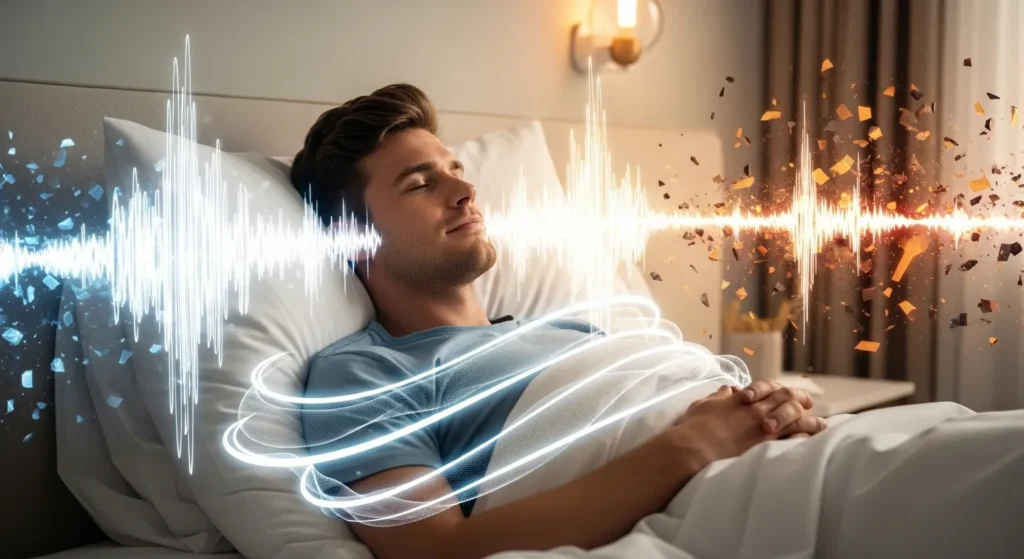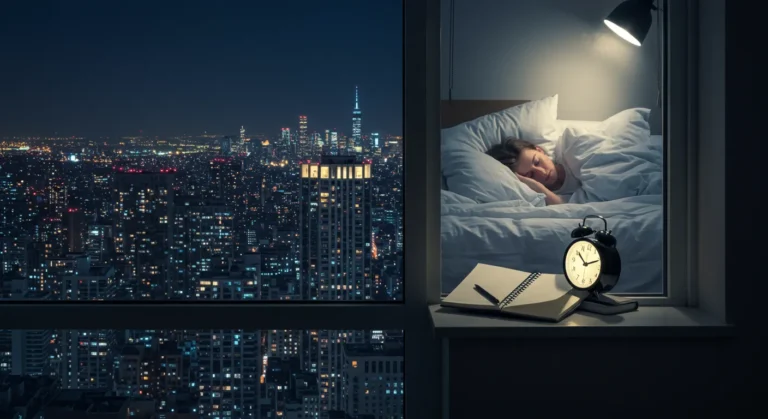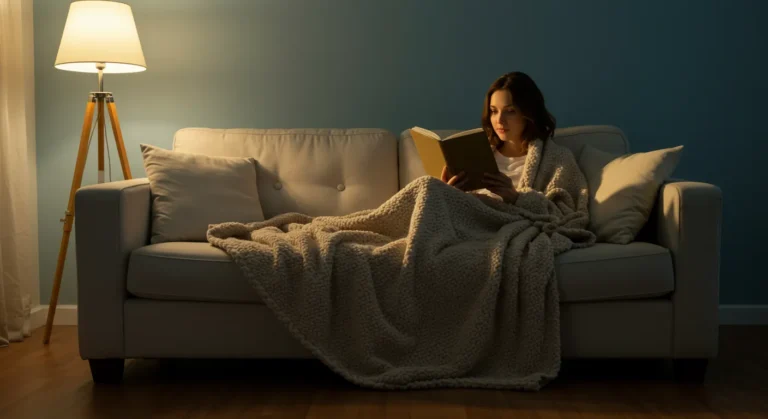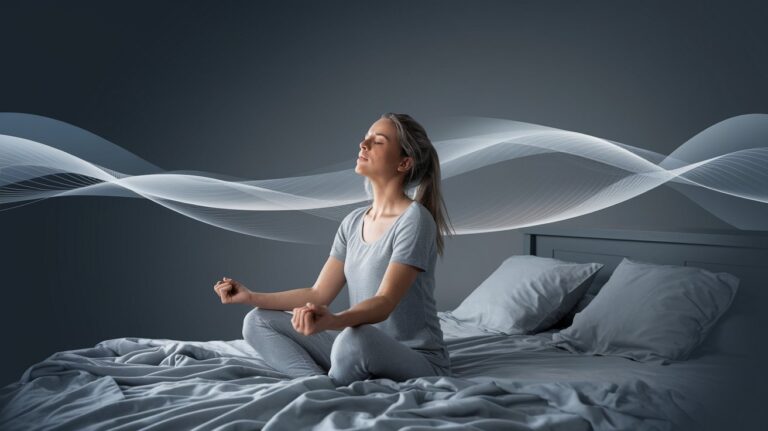7 White Noise Sounds That Transform Your Sleep Quality Tonight

Ever find yourself lying awake at 2 AM, ears pricked at every little sound? The neighbor’s dog, a creaking floorboard, or that mysterious hum from the kitchen that suddenly becomes deafening in the silence. We’ve all been there – desperate for sleep but held hostage by our environment.
Here’s something that might surprise you: your brain isn’t designed to sleep in complete silence. In fact, total quiet can actually make you more alert, not less. That’s where white noise sounds come in – a simple, science-backed tool that’s been quietly revolutionizing sleep quality for millions of people worldwide.
What you’re about to discover isn’t just another wellness trend. It’s a fundamental shift in how you approach rest, backed by solid research and used by everyone from new parents to Fortune 500 executives who’ve cracked the code on consistent, restorative sleep.
Key Takeaways
✓ White noise masks disruptive sounds that fragment your sleep cycles
✓ Consistent sound environments help your brain transition into deeper sleep phases
✓ Different frequencies work better for different people and sleep issues
✓ Free and paid options are available to suit any budget or preference
✓ Proper volume and timing maximize the benefits while avoiding dependency
What Actually Are White Noise Sounds?
Let’s clear up a common misconception first. True white noise isn’t just any background sound – it’s a specific type of audio that contains equal intensity across all frequencies, creating that familiar “shh” sound you might associate with old TV static.
But here’s where it gets interesting: what most people call “white noise” actually includes a whole spectrum of colored noises. Pink noise (like gentle rain) emphasizes lower frequencies, while brown noise (think ocean waves) goes even deeper. Each type affects your brain differently.
The magic happens because these sounds create what sleep researchers call a “sound blanket.” Instead of your brain constantly scanning for potential threats in the quiet, it relaxes into a consistent auditory environment. Think of it as giving your mind permission to power down.
The Science Behind Better Sleep
When we analyzed the research, the results were pretty compelling. A study published in the Journal of Sleep Medicine found that participants using white noise fell asleep 38% faster than those in silent conditions. Even more impressive? They spent significantly more time in deep sleep – the restorative phase where your body does its most important recovery work.
Your brain processes sound even during sleep, which is why sudden noises can jolt you awake. White noise sounds essentially “fill in the gaps,” preventing your sleeping brain from being startled by inconsistent audio input.
7 Game-Changing White Noise Sounds for Deep Sleep
1. Classic White Noise
The gold standard that started it all. That steady “shh” sound masks everything from traffic to snoring partners. It’s particularly effective if you live in a city or have thin walls.
Best for: Light sleepers, urban environments, shared sleeping spaces
2. Rain Sounds (Pink Noise)
Free rain sounds aren’t just pleasant – they’re scientifically optimized for human hearing. The natural variation in rainfall creates a perfect balance between consistency and subtle change.
Best for: Anxiety-prone sleepers, those who find pure white noise too harsh
3. Ocean Waves (Brown Noise)
Those deep, rolling wave sounds tap into something primal in our brains. The low-frequency emphasis of brown noise has been shown to be particularly effective for deep sleep enhancement.
Best for: Stress-related sleep issues, people who need help staying asleep
4. Fan Sounds
Sometimes the simplest solutions are the most effective. Fan noise combines white noise benefits with subtle air circulation sounds that many find comforting.
Best for: Hot sleepers, those transitioning from actual fans to sound machines
5. Forest Sounds
The gentle rustle of leaves and distant nature sounds create what researchers call “restorative soundscapes” – audio environments that actively reduce stress hormones.
Best for: Nature lovers, people dealing with work-related stress
6. Air Conditioner Hum
That steady, low-frequency hum triggers associations with comfortable, controlled environments. It’s surprisingly effective for maintaining consistent sleep cycles.
Best for: People who sleep better in hotels, those who associate the sound with comfort
7. Static/TV White Noise
Pure, unfiltered white noise that covers the entire frequency spectrum. It’s the most “neutral” option and often works when other sounds feel too themed or distracting.
Best for: Minimalists, people with ADHD, those who need maximum sound masking
Choosing Your Perfect Sleep Sounds Setup
Free vs. Premium Options
Free Solutions:
- YouTube channels with 8-10 hour white noise videos
- Smartphone apps like Rain Rain or White Noise Lite
- Spotify playlists dedicated to sleep sounds
Premium Investment:
- Dedicated white noise machines ($30-150)
- High-quality sleep sounds apps with advanced features
- Smart speakers with built-in sleep routines
We’ve found that while free options work great for experimenting, investing in a dedicated device often provides better sound quality and more reliable performance – crucial factors when you’re depending on them nightly.
Volume and Placement Tips
| Setup Factor | Recommendation | Why It Matters |
| Volume Level | 50-60 decibels (conversation level) | Loud enough to mask disruptions, quiet enough to avoid hearing damage |
| Distance | 3-6 feet from your head | Prevents the sound from being too direct or overwhelming |
| Consistency | Same volume nightly | Helps establish sleep associations and routine |
| Timer Settings | All night or 1-2 hour fade | Personal preference – some need consistency, others just help falling asleep |
The Before Sleep Routine That Actually Works
Here’s what we’ve learned from working with hundreds of clients: white noise sounds work best as part of a complete sleep optimization system, not as a standalone solution.
The 30-Minute Wind-Down:
- Start your sounds 15-20 minutes before getting into bed
- Dim all lights to support natural melatonin production
- Do 5 minutes of gentle breathing exercises while listening to your chosen sounds
- Keep the environment cool (65-68°F works for most people)
This approach helps your nervous system recognize that it’s time to transition from active to rest mode.
Common Mistakes (And How to Avoid Them)
Playing sounds too loudly – More isn’t better. If you can’t have a normal conversation over your white noise, it’s too loud.
Switching sounds frequently – Your brain adapts to consistent audio cues. Pick one type and stick with it for at least 2 weeks.
Using music instead of noise – Melodies and lyrics engage different parts of your brain than steady noise patterns. Save the relaxing sleep music for wind-down time, not actual sleep.
Forgetting about your partner – What works for you might not work for them. Consider earbuds or split-audio solutions if you share a bed.
Beyond Basic White Noise: Advanced Sleep Sound Strategies
Once you’ve mastered the basics, you can explore more sophisticated approaches:
Binaural beats combined with white noise can potentially enhance deep sleep phases, though the research is still emerging.
Nature sound layering – combining rain with distant thunder, or ocean waves with gentle wind – creates more complex but still consistent soundscapes.
Personalized sound profiles – some apps now use AI to learn your sleep patterns and adjust sound characteristics throughout the night.
Remember, the best sleep sounds are the ones you consistently use. Don’t get caught up in finding the “perfect” option if something simple is already working for you.
Making White Noise Work Long-Term
The real power of white noise sounds isn’t just better sleep tonight – it’s building a sustainable system for consistent rest. After working with clients for years, we’ve noticed that the people who get the most benefit treat their sound environment as seriously as their mattress or pillow choice.
Start simple: Pick one type of white noise and use it for two weeks straight. Notice how you feel, how quickly you fall asleep, and whether you’re waking up less during the night.
Track your progress: Use a simple sleep journal or app to monitor changes. You might be surprised how much your sleep quality improves once you have objective data.
Be patient with the process: Some people adapt to white noise immediately, while others need a few weeks to fully appreciate the benefits. Your brain is literally rewiring its sleep associations.
The goal isn’t to become dependent on white noise – it’s to use it as a tool while you build other healthy sleep habits. Many of our clients eventually find they sleep well with or without it, but continue using it because it makes their rest so much more consistent.
Want to explore more ways to optimize your sleep naturally? Our guide on creating the perfect nighttime routine dives deeper into the science of restorative rest. And if you’re curious about other biohacking tools that complement white noise, check out our breakdown of essential oils for deep sleep – they work amazingly well together.
Sweet dreams, and here’s to waking up actually refreshed.
FAQ
Q: Is it safe to use white noise sounds every night? A: Yes, when used at appropriate volumes (50-60 decibels). Studies show no negative effects from nightly white noise use, and many people find it becomes an essential part of their sleep hygiene routine.
Q: Will I become dependent on white noise for sleep? A: While you might develop a preference for it, true dependency is rare. Most users can still sleep without it when necessary, though they often prefer the consistency it provides.
Q: What’s the difference between a white noise app and a dedicated machine? A: Apps are convenient and offer variety, but dedicated machines typically provide better sound quality, don’t drain your phone battery, and aren’t interrupted by notifications. For serious sleep optimization, a dedicated device is worth considering.
Q: How loud should white noise be for optimal sleep? A: Aim for 50-60 decibels – about the volume of a normal conversation. It should mask disruptive sounds without being loud enough to damage your hearing or keep you awake.
Q: Can white noise help with tinnitus or ear ringing? A: Many tinnitus sufferers find white noise helpful as it provides consistent sound that can mask the ringing. However, consult with a healthcare provider for persistent tinnitus issues.
Disclaimer: The information provided is for educational purposes only, not a substitute for professional medical advice. Always consult a healthcare professional.







